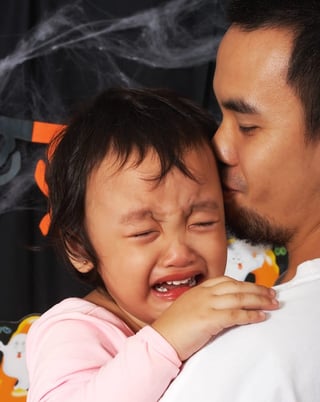
Whether it occurs at random, at bedtime, during dinner, or simply when you say no, crying can be extremely difficult for parents to deal with. For many, the reflex response is to comfort. For others, crying has become a nuisance; something that their children do to get what they want. But for most parents of chronic criers, they are simply in need of a solution; one that will help their children to positively cope and be less stressful for themselves in the long-run. I have the solution, but I also want to challenge your reluctance to see tears. Is your child’s crying unwarranted? Or does the simple act of witnessing the expression of emotion make you uncomfortable?
Why Do We Cry?
Before delving into the solution for crying (because it is simpler than you may think), let’s first try to understand why we cry. Humans are the only creatures currently known to cry due to their feelings, and tears have the role of soliciting attention and care. But why do we as parents, spouses, and generally caring individuals tend to respond so strongly to crying? Research has not provided solid answers.
Most scientists argue that tears have no benefit other than lubricating the eyes. However, current research is beginning to build sound theory surrounding the idea that emotional tears are chemically different than tears that occur due to irritation (e.g. cutting onions). These tears can be seen easier because they are more viscous and the chemical makeup of emotional tears may even reduce aggression in others (Gelstein, Yeshurun, Rozenkrantz, Shushan, Frumin, Roth & Sobel, 2011). So, it seems that we are just biologically composed to respond to tears. Whether this response is with empathy or frustration, is dependent upon the individual. However, our responses influence our children and often shape their behavior.
So, What Should We Do?
Although debated, research has shown that crying is cathartic (Rottenberg, Bylsma & Vingerhoets, 2008). For many, it can act as a release of negative emotion and aid in feeling better. So, one of the simplest solutions for a hypersensitive child or even a child who uses crying as an attention seeking behavior, is to allow them to cry. Even though it probably will make you feel uncomfortable, it is okay for you to let your child express their feelings. Trying to curb the behavior by coddling, debating, or yelling will be highly reinforcing and you may find that your child will cry just to gain your attention, not because they truly feel an emotional need.
Now if a child is in critical need of care, letting them cry is not appropriate. Instead, providing them with the support that they need is critical, whether this be a hug, Band-Aid, or a hospital visit. However, for less serious behaviors that are often associated with tears, such as sulking and tantrums, ignoring the behavior and letting them cry works wonders. This simple solution is called tactical ignoring. With tactical ignoring, you give no outward sign of recognizing a behavior (e.g. no eye contact, no verbal response, no physical response). Only when the crying, sulking, or tantruming has stopped, should your child be reinforced with your attention. Though it may be frustrating in the beginning, it will be helpful in the long-run. Crying isn’t really the problem, it’s how we respond to it that creates chaos!
References:
Gelstein, S., Yeshurun, Y., Rozenkrantz, L., Shushan, S., Frumin, I., Roth, Y., & Sobel, N. (2011). Human tears contain a chemosignal. Science, 331(6014), 226-230.
Rottenberg, J., Bylsma, L. M., & Vingerhoets, A. J. (2008). Is crying beneficial?. Current Directions in Psychological Science, 17(6), 400-404.





